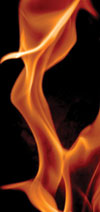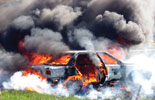

Steve Jansen, Sr. VP of Sales at Fireaway discusses Stat-X.
Aerosol fire suppression technology was first pioneered in the Soviet Union over 20 years ago as a result of work done on the Soyuz rocket programme. Aerosol fire suppression technology based on a potassium compound was discovered to be a superior fire suppression technology versus gas or foam systems for many applications. The advantages of the potassium aerosol generators were significant, including large savings in weight and space, procurement costs, installation costs, ongoing maintenance costs and the potential for a safe, green and highly effective fire suppression agent. However, the technology was very young and many issues needed to be overcome to make the technology a solid commercial offering.
Over time, the technology spread to other institutes in Russia and after the dissolution of the Soviet Union, the owners of the technology offered licences to interested parties to develop and resell the products. They also offered licensees the ability to continue to procure the potassium-based compound from various sources within Russia. A number of companies including Pyrogen and FirePro obtained a licence and began to market Russian sourced products based on the original Russian compound with little, if any refinement.
These products are commonly referred to as Generation 1 products and while offering many advantages over gas or foam systems, they had some drawbacks including the cleanliness and consistency of the agent, construction of the generators, high temperature created during a system activation and overall product quality due to the Russian manufacturing processes. To further complicate the issue, there was no recognised standard for aerosol fire suppression products within the industry for standards bodies to test and certify against and to guide the manufacturers in building quality products.
Next generation
Fireaway also recognised the potential of this technology and obtained a licence for the technology, but rather than developing and sourcing a product based on the early Soviet architecture, we decided to redo the technology from the ground up to offer a product that would address the issues of Generation 1 products.
This included a complete redesign of the generator, the device that contains the aerosol-forming compound and upon activation produces the aerosol agent to solve the issues of high heat and product longevity and integrity. Fireaway uses only stainless steel components and the highest quality materials, such as activated alumina for cooling, and controls the entire manufacturing process of our generators.
More importantly, Fireaway recognised that the quality of the aerosol produced was wholly dependent upon the quality of the chemicals that were used to create the compound, as well as, tight controls on the manufacturing process itself. Fireaway produces the compound using only reagent grade chemicals (>99,5% pure) with a patented, proprietary formulation and manufacturing process which ensure consistent production of a cleaner aerosol without the negative by-products associated with some of the early generation 1 products.
Fireaway calls its aerosol fire suppression products Stat-X. The company has been active in participating with these worldwide certification agencies and currently has more significant approvals than any other aerosol fire suppression product.
These agencies not only test the robustness and integrity of the products, the manufacturing process, related manufacturers documentation and installation processes but also ensure that they are able to extinguish numerous fire conditions in order to be certified. In addition, Fireaway has also submitted its products to various government agencies such as the US Environmental Protection Agency (EPA) to determine where our aerosol products may be safely used. The US EPA has certified Stat-X as safe for use in normally unoccupied spaces.

Visibility restrictions
It is important to note that the reason Stat-X has been certified for what is known as normally unoccupied spaces and not for use in normally occupied spaces has nothing to do with toxicity issues but rather, issues of potential obscuration. Upon activation, the Stat-X generator produces a dense, white cloud of aerosol that is very buoyant and will hang in suspension for up to an hour with little if any residue.
While the agent is an extremely effective suppression agent, it also obscures visibility, making egress potentially difficult for anyone in a space during the activation. It is also important to note that the NFPA 2010 standard mandates a 30-second time delay for system activation upon fire detection for aerosols in normally unoccupied spaces such as a computer room to allow personnel to safely exit the space prior to system discharge. This is good fire protection policy and should be used regardless of the agent being used and is, in fact, also specified for gas agents covered under NFPA 2001.
As an integral part of the certification process, the certifying agency determines what is known as an agent application rate. This is a standard measure, which includes a 30% safety factor that is applied to all products of a certain type of extinguishing method. This determines the amount of agent that must be applied when proposing their products to end users. Aerosols, just like gases such as FM-200, are classified as Total Flooding Agents meaning they are designed to protect hazards in enclosed spaces with the agent completely flooding the space that contains the hazard.
The exact amount of the application rate is determined by comprehensive testing of the agent on actual fire conditions. Stat-X has consistently been awarded not only the lowest application rate of all tested and certified aerosol products but an application rate lower than any gas product available today. In fact, Stat-X has been proven to be 5-times more effective (by mass) than halon 1301 and 10 times more effective than halon alternatives such as FM-200.

Non-toxic suppression
As you know, halon gas was one of the most effective agents ever produced for fire suppression. Unlike agents such as FM-200, which works primarily by cooling a fire, or CO2, which removes oxygen from the environment, halon gas suppressed fire by breaking the chemical reaction created in a fire condition. This is widely recognised as the most effective means of fire suppression.
However, halon gas had numerous negative side effects such as thermal breakdown in a fire condition, which created toxic gases and acids, and halon gas was determined to destroy ozone and add to global warming and has thus been banned in most of the world. Stat-X aerosol works in the same manner as halon, chemical interruption of a fire, but unlike halon or other gas agents Stat-X does not breakdown in a fire and does not create any acidic by-products.
Also, unlike CO2, Stat-X does not remove oxygen from the environment that can be lethal to humans who may be present during a CO2 discharge. Stat-X aerosol is also discharged at very low pressure, <50 psi, making it much safer for discharge around sensitive equipment and even appropriate for discharge inside electrical cabinets, chemical storage lockers, etc.
Additionally, because the Stat-X aerosol generator is self-contained with the agent, discharge device and activation element all contained within the generator, no expensive piping is required for installation. This results in significant installation and ongoing maintenance savings over gas systems.
In summary, aerosol fire suppression technology has been around for quite some time but has only within the last five years begun to gain widespread market acceptance and customer adoption.
| Tel: | +27 11 794 9144 |
| Email: | [email protected] |
| www: | www.technoswitch.co.za |
| Articles: | More information and articles about Technoswitch Fire Detection & Suppression |

© Technews Publishing (Pty) Ltd. | All Rights Reserved.